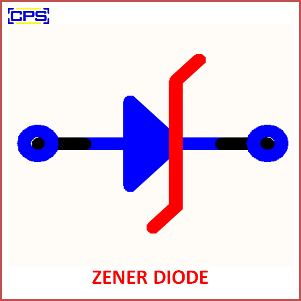A Zener Diode is a type of diode designed to allow current to flow normally in the forward direction, like a regular diode, but to also allow current to flow in the reverse direction when the voltage exceeds a certain value known as the Zener voltage (or breakdown voltage). The Zener diode is commonly used for voltage regulation and protection in electronic circuits.

Key Features of Zener Diode:
- Reverse Breakdown:
- Unlike a regular diode, which prevents current flow in the reverse direction, a Zener diode is designed to break down and conduct current in reverse when the voltage exceeds its rated Zener voltage.
- Zener Voltage:
- The Zener diode has a precise and fixed reverse breakdown voltage. When the reverse voltage exceeds this threshold (the Zener voltage), the diode allows current to flow in the reverse direction, maintaining a stable voltage across it. This voltage is typically between 3.6V to several hundred volts depending on the diode specifications.
- Voltage Regulation:
- Due to its ability to clamp the voltage across it at the Zener voltage, the Zener diode is widely used for voltage regulation. It ensures that the voltage remains stable, regardless of variations in input voltage or load conditions.
- Symbol:
- The symbol for a Zener diode is similar to the symbol of a regular diode, but with two small arrows pointing away from the cathode, indicating its reverse breakdown behavior.
Applications of Zener Diode:
- Voltage Regulation:
- Zener diodes are widely used in power supplies for voltage regulation, where they maintain a stable output voltage despite fluctuations in input voltage or load.
- Surge Protection:
- Zener diodes are used to protect circuits from voltage spikes or surge protection by clamping the voltage to a safe level and preventing damage to sensitive components.
- Shunt Voltage Clamping:
- Zener diodes are used for shunt voltage clamping, where they are placed in parallel with a component to limit the maximum voltage that can appear across it, thus protecting it from over-voltage.
- Waveform Clipping:
- In signal processing, Zener diodes are used for waveform clipping to limit the amplitude of signals and prevent distortion or damage to circuits due to high voltage levels.
- Regulated Power Supplies:
- Zener diodes are often used in low-power regulated power supplies to stabilize the output voltage and ensure reliable operation of electronic devices.
Advantages of Zener Diode:
- Stable Voltage Output:
- Zener diodes provide a stable voltage output, making them useful in voltage regulation applications.
- Simple and Reliable:
- Zener diodes are simple, low-cost components that provide reliable voltage regulation without the need for complex circuitry.
- Over-voltage Protection:
- Zener diodes are effective in protecting circuits from voltage spikes, which could otherwise damage sensitive components.
- Available in Different Ratings:
- Zener diodes are available in a wide range of Zener voltages, making them versatile for various applications requiring specific voltage regulation.
Disadvantages of Zener Diode:
- Limited Power Handling:
- Zener diodes typically have a low power rating, and therefore, they may not be suitable for high-power applications unless proper heat dissipation is provided.
- Temperature Sensitivity:
- The Zener voltage of a Zener diode can vary with temperature, which may lead to performance changes in temperature-sensitive applications.
- Efficiency:
- Zener diodes are less efficient compared to other voltage regulation techniques like switch-mode regulators, as they dissipate power in the form of heat when regulating voltage.
